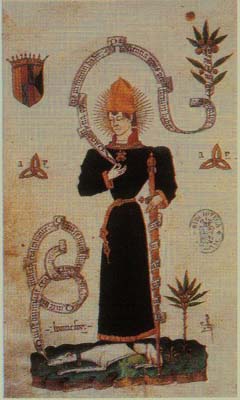Charles, Prince of Viana facts for kids
Quick facts for kids Charles IV |
|
|---|---|
 |
|
| King of Navarre de jure only |
|
| Reign | 1441–1461 (Contested by John II) |
| Predecessor | Blanche I and John II |
| Successor | Blanche II |
| Born | 29 May 1421 Peñafiel |
| Died | 23 September 1461 (aged 40) Barcelona |
| Spouse | Agnes of Cleves |
| House | Trastámara |
| Father | John II of Aragon |
| Mother | Blanche I of Navarre |
| Religion | Roman Catholicism |
Charles, Prince of Viana (May 29, 1421 – September 23, 1461), sometimes known as Charles IV of Navarre, was an important figure in Spanish history. He was the son of King John II of Aragon and Queen Blanche I of Navarre.
Contents
Early Life and Inheritance
Charles was born in 1421. His mother, Queen Blanche I, was the daughter of King Charles III of Navarre. Both his grandfather and mother wanted Charles to inherit the Kingdom of Navarre. They had officially named him as the rightful heir.
However, when Queen Blanche died in 1441, Charles's father, John II, took control of Navarre himself. He did this even though Charles was the rightful heir. This decision led to many problems between father and son.
Marriages and Family
Charles, Prince of Viana, married Agnes of Cleves in 1439. Agnes was the daughter of Adolph I, Duke of Cleves. She passed away in 1448 without having any children.
After Agnes's death, Charles had three children outside of marriage. These children were:
- Anna, Countess of Medinaceli
- Philip, who became Archbishop of Palermo
- John, who became Bishop of Huesca
Charles later considered marrying again, but these plans did not happen before he died.
Conflict with His Father
The relationship between Charles and his father, King John II, became very difficult. This was made worse when John II married his second wife, Juana Enriquez. Juana had a son, Ferdinand II of Aragon, and she saw Charles as a rival for the throne.
When Juana started getting involved in Navarre's affairs, a civil war broke out. In 1452, Charles was defeated and captured by his father's forces. He was released after promising not to claim the title of king until his father died.
Charles tried to fight again but was unsuccessful. He then sought safety with King Alfonso V of Aragon in Naples. When Alfonso died in 1458, John II became King of Aragon. Charles was offered the crowns of Naples and Sicily, but he turned them down.
He made peace with his father and returned to Navarre in 1459. However, when Charles wanted to marry Isabella of Castile, his father imprisoned him again. This caused the people of Catalonia to rise up in support of Charles. The rebellion grew, and John II was forced to give in. He released Charles and recognized him as the permanent governor of Catalonia and the heir to the kingdom.
Death and Legacy
Charles died soon after, on September 23, 1461, in Barcelona.
Charles was known as a cultured and kind prince. He loved music and books. He translated a famous book by Aristotle called Ethics into Aragonese. He also wrote a history book about the kings of Navarre, called Cronica de los reyes de Navarra.
See also
 In Spanish: Carlos de Viana para niños
In Spanish: Carlos de Viana para niños

